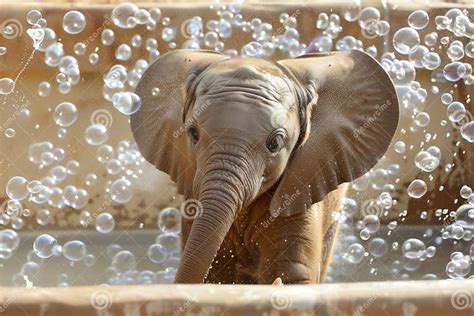
A young elephant in Botswana provided amusement for onlookers and its own herd after an unsuccessful attempt to drink from a water trough, resulting in a headfirst plunge that was caught on video. The incident, which occurred at the Duba Plains Camp, showcases the playful yet sometimes clumsy nature of young elephants as they learn to navigate their environment.
A video of the incident, which was posted on social media, has gone viral and has captured the hearts of viewers around the globe. The footage shows the young elephant approaching the water trough and attempting to reach the water with its trunk. However, the elephant misjudges the distance and ends up tumbling headfirst into the trough. The other elephants in the herd react to the unexpected event with curiosity and concern, gathering around the trough to investigate.
The video of the baby elephant’s misadventure was captured by Nicki Coetzee, a guest at the Duba Plains Camp. “We were watching the elephants drinking at the water trough in front of the Duba Plains camp when this little one tried to reach the water, lost his balance, and went right in,” Coetzee told a media outlet. “The rest of the herd was very curious and came to investigate, but he managed to get himself out fairly quickly, and all was well.”
The incident highlights the challenges that young elephants face as they learn to coordinate their movements and interact with their surroundings. Elephants rely on their trunks for a variety of tasks, including drinking, feeding, and communication. However, mastering the use of their trunks takes time and practice, and young elephants often make mistakes along the way.
The Duba Plains Camp, where the incident occurred, is located in the Okavango Delta, a vast inland river system in Botswana that is home to a diverse array of wildlife, including elephants, lions, leopards, and hippos. The camp is committed to responsible tourism and works to minimize its impact on the environment and support local communities.
Elephant Calves and Learning to Drink:
The process of how elephant calves learn to drink and manage their trunks is crucial for their survival and development. Newborn elephants do not automatically know how to use their trunks effectively; it’s a learned skill that requires coordination and practice.
Initially, elephant calves rely on their mouths to suckle milk from their mothers. They gradually start experimenting with their trunks, mimicking their mothers’ actions. This experimentation involves a lot of trial and error, and young elephants often struggle to control their trunks in the early months.
The trunk of an elephant is an incredibly versatile organ, composed of over 40,000 muscles. These muscles allow the elephant to perform a wide range of tasks, from picking up small objects to uprooting trees. However, this complexity also means that it takes time for young elephants to develop the necessary muscle control and coordination.
When learning to drink, elephant calves typically dip their trunks into water and then bring the trunk to their mouths to squirt the water in. This process requires precise movements and timing. Calves often misjudge the distance or lose their balance, leading to comical situations like the one seen in the viral video.
The herd plays a crucial role in teaching young elephants how to use their trunks. Mothers and other adult females demonstrate the proper techniques and provide guidance. Calves learn by observing and imitating the behavior of older elephants. The herd also provides a safe and supportive environment for calves to practice and develop their skills.
The Significance of Water Troughs in Elephant Habitats:
Water troughs and watering holes are essential resources for elephants, particularly in arid and semi-arid environments. These artificial water sources can provide a reliable supply of water, especially during the dry season when natural water sources may be scarce.
Elephants require large amounts of water to survive. An adult elephant can drink up to 50 gallons of water per day. Water is crucial for regulating body temperature, aiding digestion, and maintaining overall health. Without access to sufficient water, elephants can become dehydrated and vulnerable to disease.
Water troughs can also help to reduce human-wildlife conflict. By providing elephants with a reliable water source, they are less likely to venture into agricultural areas or human settlements in search of water. This can help to protect crops and property and reduce the risk of encounters between humans and elephants.
However, water troughs can also have negative impacts on elephant populations. They can concentrate elephants in certain areas, leading to overgrazing and habitat degradation. They can also increase the risk of disease transmission, as elephants may come into close contact with each other at water troughs.
The management of water troughs is therefore crucial for ensuring the long-term sustainability of elephant populations. It is important to carefully consider the location, design, and maintenance of water troughs to minimize their negative impacts and maximize their benefits. Regular monitoring of elephant populations and their use of water troughs is also essential.
Herd Dynamics and Social Learning in Elephants:
Elephants are highly social animals that live in complex family groups called herds. These herds are typically led by an older, experienced female known as the matriarch. The matriarch plays a crucial role in guiding the herd, making decisions about where to find food and water, and protecting the herd from danger.
Elephant herds are typically composed of related females and their offspring. Male elephants typically leave the herd when they reach adolescence and form bachelor groups or live solitary lives. However, they may still interact with female herds during mating season.
The social structure of elephant herds is based on strong bonds of kinship and cooperation. Elephants communicate with each other using a variety of vocalizations, gestures, and touch. They also exhibit a range of complex social behaviors, such as alloparenting (where individuals other than the mother help to care for young calves) and cooperative defense against predators.
Social learning is an important aspect of elephant behavior. Young elephants learn many essential skills by observing and imitating the behavior of older elephants. This includes how to find food and water, how to use their trunks, and how to navigate their environment. The viral video of the baby elephant falling into the water trough provides a clear example of social learning, as the other elephants in the herd immediately gathered around to investigate and offer assistance.
The social bonds within elephant herds are crucial for the survival and well-being of individual elephants. Elephants rely on each other for support, protection, and companionship. The loss of a family member can have a profound impact on the remaining elephants in the herd.
Conservation Challenges and the Future of Elephants:
Elephants face a number of serious threats to their survival, including habitat loss, poaching, and human-wildlife conflict. Habitat loss is driven by deforestation, agricultural expansion, and urbanization. As elephant habitats shrink, elephants are forced to compete with humans for resources, leading to conflict.
Poaching is another major threat to elephants. Elephants are poached for their ivory, which is used to make ornaments and other luxury goods. The illegal ivory trade has decimated elephant populations in many parts of Africa.
Human-wildlife conflict is also a growing problem. As human populations expand and encroach on elephant habitats, elephants are increasingly likely to come into contact with humans. This can lead to crop raiding, property damage, and even human fatalities.
Conserving elephants requires a multifaceted approach that addresses these threats. This includes protecting and restoring elephant habitats, combating poaching, mitigating human-wildlife conflict, and promoting sustainable development. Community-based conservation initiatives, which empower local communities to manage and benefit from wildlife, are also crucial for the long-term survival of elephants.
The future of elephants depends on our ability to address these challenges and create a world where elephants and humans can coexist peacefully. This requires a commitment to conservation, sustainable development, and ethical treatment of animals.
Detailed Breakdown of the Elephant’s Water Trough Mishap
The incident at Duba Plains Camp, where the baby elephant took an unexpected dive into the water trough, offers a captivating glimpse into the everyday lives and learning processes of these magnificent creatures. While seemingly a simple and humorous event, it underscores several important aspects of elephant behavior, ecology, and conservation. Let’s dissect this event in detail.
1. The Setting: Duba Plains Camp and the Okavango Delta
- Location Significance: Duba Plains Camp is situated within the Okavango Delta, a unique inland delta in Botswana. This ecosystem is critical for a diverse range of wildlife, including a significant elephant population. The Okavango Delta provides a crucial source of freshwater in an otherwise arid region, making it a vital habitat for elephants, especially during the dry season.
- Camp’s Role: The camp serves as a hub for ecotourism, providing visitors with opportunities to observe wildlife in their natural habitat. Camps like Duba Plains often implement conservation practices to minimize their environmental impact and contribute to the local community. Artificial water sources, like the trough, are sometimes provided to ensure wildlife has access to water, particularly during drier periods.
2. The Incident: A Detailed Account
- Circumstances: The baby elephant approached the water trough, likely seeking to quench its thirst. Young elephants are still developing their motor skills and coordination, particularly when it comes to using their trunks effectively.
- The Fall: The elephant likely misjudged the distance or angle required to reach the water. The weight of its head and trunk, combined with a possible misstep, caused it to lose balance and tumble headfirst into the trough.
- Immediate Aftermath: The fall would have been disorienting for the young elephant. The depth of the trough and the unfamiliar sensation of being submerged would likely have caused some distress.
3. Herd Reaction: Social Bonds and Support
- Curiosity and Concern: The reaction of the other elephants in the herd is crucial. They immediately gathered around the trough, displaying a mixture of curiosity and concern. This behavior highlights the strong social bonds within elephant herds.
- Investigative Behavior: The elephants likely used their trunks to investigate the situation, trying to assess the well-being of the calf and determine if assistance was needed.
- Potential Assistance: While the article mentions the calf got out on its own, it’s important to note that adult elephants often assist young ones in distress. They might use their trunks or tusks to help lift a calf out of a ditch or other difficult situation.
4. Elephant Trunk Development: A Learning Curve
- Trunk Complexity: An elephant’s trunk is an incredibly complex organ, containing over 40,000 muscles and serving multiple functions, including drinking, breathing, smelling, grasping, and communication.
- Learning Process: Young elephants don’t automatically know how to use their trunks effectively. It’s a skill that develops over time through practice and observation. They learn by mimicking their mothers and other adult elephants.
- Early Challenges: During the learning process, calves often struggle with coordination and control. They may accidentally suck up dirt, spray water in the wrong direction, or, as in this case, lose their balance.
5. Water Troughs: Benefits and Considerations
- Water Source: Water troughs provide a reliable source of water for elephants and other wildlife, especially during dry periods when natural water sources are scarce.
- Potential Drawbacks: Concentrating animals around artificial water sources can lead to localized overgrazing and habitat degradation. It can also increase the risk of disease transmission.
- Management Strategies: Careful management of water troughs is essential to minimize negative impacts. This includes regular maintenance, strategic placement, and monitoring of animal behavior.
6. Conservation Implications: The Bigger Picture
- Habitat Loss: Habitat loss due to deforestation, agriculture, and urbanization is a major threat to elephant populations. As their habitat shrinks, elephants are forced to compete with humans for resources.
- Human-Wildlife Conflict: This competition can lead to increased human-wildlife conflict, as elephants may raid crops or damage property.
- Conservation Efforts: Protecting elephant habitats, mitigating human-wildlife conflict, and combating poaching are crucial for the long-term survival of these magnificent animals.
7. The Viral Video: A Window into Elephant Life
- Educational Value: The viral video, while entertaining, also provides a valuable opportunity to educate people about elephants and their behavior.
- Promoting Conservation: Such videos can raise awareness about the challenges elephants face and inspire people to support conservation efforts.
- Responsible Tourism: It also highlights the importance of responsible tourism practices that prioritize the well-being of wildlife and minimize disturbance to their natural habitat.
In conclusion, the baby elephant’s comical tumble into the water trough is more than just a funny video. It’s a glimpse into the complex lives of elephants, highlighting their social bonds, learning processes, and the challenges they face in a changing world. By understanding these aspects, we can better appreciate these magnificent creatures and support efforts to ensure their survival for generations to come.
Frequently Asked Questions (FAQ)
Q1: What exactly happened to the baby elephant at the Duba Plains Camp?
A1: According to reports, a young elephant at the Duba Plains Camp in Botswana attempted to drink from a water trough but lost its balance and fell headfirst into the water. This humorous incident was captured on video and has since gone viral. “We were watching the elephants drinking at the water trough in front of the Duba Plains camp when this little one tried to reach the water, lost his balance, and went right in,” said Nicki Coetzee, who filmed the event.
Q2: How did the other elephants in the herd react to the baby elephant’s fall?
A2: The other elephants in the herd displayed curiosity and concern. They gathered around the water trough to investigate, likely assessing the situation and the well-being of the calf. This reaction highlights the strong social bonds and cooperative behavior within elephant herds. According to the person who captured the video, “The rest of the herd was very curious and came to investigate.”
Q3: Where is the Duba Plains Camp and why is it significant for wildlife?
A3: The Duba Plains Camp is located in the Okavango Delta in Botswana, a vital ecosystem for a diverse range of wildlife, including elephants, lions, leopards, and hippos. The Okavango Delta provides a crucial source of freshwater in an arid region. Camps like Duba Plains often implement conservation practices to minimize their environmental impact and support the local community.
Q4: Why do elephants need water troughs, and are there any downsides to them?
A4: Water troughs provide a reliable source of water for elephants and other wildlife, especially during dry periods when natural water sources are scarce. An adult elephant can drink up to 50 gallons of water per day. However, concentrating animals around artificial water sources can lead to localized overgrazing, habitat degradation, and increased risk of disease transmission. Careful management of water troughs is essential to minimize these negative impacts.
Q5: What are the main threats facing elephants today, and how can we help protect them?
A5: The main threats facing elephants include habitat loss, poaching, and human-wildlife conflict. Habitat loss is driven by deforestation, agricultural expansion, and urbanization. Poaching is driven by the demand for ivory. Human-wildlife conflict arises as humans and elephants compete for resources. We can help protect elephants by supporting conservation organizations, promoting sustainable development, and advocating for policies that protect elephant habitats and combat poaching.









